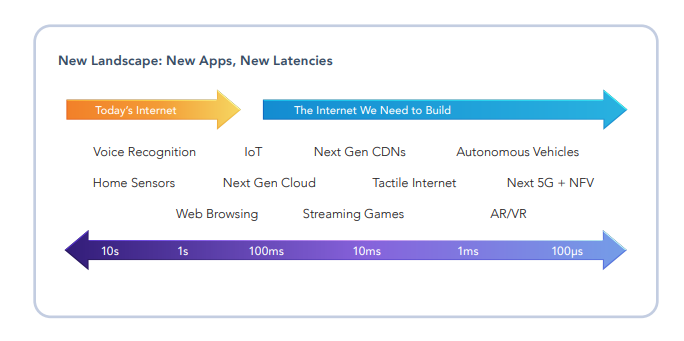The Internet we need versus the internet we have
In a few short decades since the advent of the internet, tracking its astronomical prevalence within society, even with the benefit of hindsight, is staggering. Evolving from wired home connection to completely seamless wireless connectivity on a plethora of everyday devices, nowadays fridges, security cameras, traffic lights and medical equipment can be and are all connected to the Internet. As exciting and groundbreaking technologically forward new IoT devices like self-driving cars and emergency response technologies become a more realistic fixture in our existence, Internet infrastructure must evolve purely to keep up.
In a few short decades since the advent of the internet, tracking its astronomical prevalence within society, even with the benefit of hindsight, is staggering. Evolving from wired home connection to completely seamless wireless connectivity on a plethora of everyday devices, nowadays fridges, security cameras, traffic lights and medical equipment can be and are all connected to the Internet. As exciting and groundbreaking technologically forward new IoT devices like self-driving cars and emergency response technologies become a more realistic fixture in our existence, Internet infrastructure must evolve purely to keep up.
In its current form, Internet data infrastructure is centralised. If the end user is in the eastern suburbs of Melbourne, their data may have to travel between there and a regional data centre on the other side of the city. This creates delay, or latency, which is only increased by the additional pressure of 20+ million IoT devices on the network today. For all these IoT devices to perform quickly and transfer data reliably, Internet infrastructure needs improvement.
To fully understand the Internet we have versus the Internet we need, we’ll need to take a look at how the current infrastructure developed in three acts.
The First Act: Centralised data centres
The Internet started out as a network that got data purely from A to B. This meant that any browser could connect to any server. Information had to travel huge distances, often between countries or across oceans, to be processed in one big centralised data centre. This, of course, led to a lot of delay and slow speeds which were major limitations of the early Internet.
The Second Act: The Cloud
When the cloud, wireless technology and modern web browsers emerged alongside higher-speed connections like Broadband, the Internet grew exponentially as well and ushered in new requirements. This second act put forward the need for cloud computing and regional data centres to manage the sheer volume of data. With these updates, data could now be housed closer to the user so it no longer needed to travel across continents for every request, increasing speed and efficiency.
These evolutions started to improve performance enough to drive 3G and 4G network expansions. They also paved the way for high-fidelity websites, instant page loads, and streaming services. But these, along with IoT devices and 5G, have now created unprecedented demand for faster and more reliable data.
We’re now entering The Third Act: Edge Computing:
Unlike cloud processing which relies on a handful of regional data centres, edge computing handles data hyper-locally to the source, or the ‘edge’. Although the cloud is still useful for large volumes of data storage, edge computing is much better at instantly handling time-sensitive or critical events.
By having a data centre physically closer to the end user, the distance data must travel is vastly reduced, which increases internet speed and delays issues like lagging and latency. To understand how this works, it is best to imagine two cars entering a race. Both race cars are the same make and model, with the same capacity. They are both equally fast, but one car starts the race one kilometre from the finish line while the other can get a head start and enters the race just 100 meters from the finish line. It’s not hard to guess which one will win when considering that it is not the speed of the cars that determines the outcome, but instead the distance they each must travel.
The very same logic applies to data. There is a prevailing obsession with speed amongst many people familiar with the space. However, ultimately it doesn’t matter how fast the data travels when the data has to travel between an end user and a data centre that are physically far from each other. This example is the very definition of speed versus latency, and a source of incredible frustration for a number of internet users who test their internet speed, find it to be in a high range but still suffer from a lagging service.
To keep up with the incredible technological breakthroughs that are continuing to become more prevalent in society, essentially the third act of the internet needs to be enacted, and edge distance needs to be dramatically reduced.

Take self-driving cars for example. If self-driving cars are going to be viable, they would need the same, if not better, reaction time than a human driver. Imagine if a person walked in front of a self-driving car. It would have to be able to make the snap decision to stop immediately. If the data had to be sent to the cloud and back again, it could take too long for the car to stop and an accident would occur. With edge computing, the signal to stop would be immediate.
As edge computing allows IoT technology to make snap decisions, this has far-reaching potential in manufacturing, medical and emergency response equipment too.
Businesses are expected to invest $700 billion in edge computing over the next 10 years. By 2028, forecasted total spend is $146 billion with a 35% compound annual growth rate. The Asia Pacific will account for 36.7% of global edge computing.
DXN Limited is one of the few companies that’s building and maintaining edge computing infrastructure today. The Australian company manufactures modular data centres that are setting future Internet users up for faster data processing in the IoT age.
Their modular edge data centres are a unique piece of the puzzle in the third act of the internet. Roughly the size of a shipping container, these data centres are far smaller compared to legacy data centres. They can be assembled off-site and deployed anywhere there’s room like car parks or at the base of mobile phone towers. Unlike big data centres which can take years to set up, these modular data centres can be built and installed in months. As these data centres are so close to end users, delays are drastically reduced.
To stay informed on DXN Limited, click here to receive news, updates and invites to online investor briefings.
Reach Markets have been engaged by DXN Limited to assist with private investor management.
General Advice Warning
Any advice provided by Reach Markets including on its website and by its representatives is general advice only and does not consider your objectives, financial situation or needs, and you should consider whether it is appropriate for you. This might mean that you need to seek personal advice from a representative authorised to provide personal advice. If you are thinking about acquiring a financial product, you should consider our Financial Services Guide (FSG) including the Privacy Statement and any relevant Product Disclosure Statement or Prospectus (if one is available) to understand the features, risks and returns associated with the investment.
Please click here to read our full warning.




